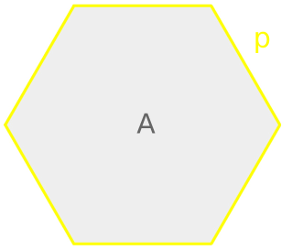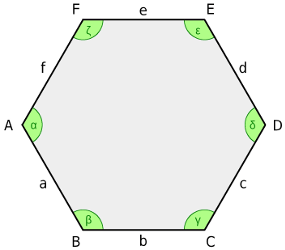1D Line , Circular Arc , Parabola , Helix , Koch Curve
2D
Regular Polygons: Equilateral Triangle , Square , Pentagon , Hexagon , Heptagon , Octagon , Nonagon , Decagon , Hendecagon , Dodecagon , Hexadecagon , N-gon , Polygon Ring Other Polygons: Triangle , Right Triangle , Isosceles Triangle , IR Triangle , 1/2 EL Triangle , Golden Triangle , Quadrilateral , Rectangle , Golden Rectangle , Rhombus , Equidiagonal Rhombus , Parallelogram , Kite , 60-90-120 Kite , Half Square Kite , Right Kite , Trapezoid , Right Trapezoid , Isosceles Trapezoid , Tri-equilateral Trapezoid , Obtuse Trapezoid , Cyclic Quadrilateral , Tangential Quadrilateral , Arrowhead , Concave Quadrilateral , Crossed Rectangle , Antiparallelogram , House-Shape , Symmetric Pentagon , Diagonally Bisected Octagon , Cut Rectangle , Concave Pentagon , Concave Regular Pentagon , Stretched Pentagon , Straight Bisected Octagon , Stretched Hexagon , Symmetric Hexagon , Semi-regular Hexagon , Parallelogon , Concave Hexagon , Arrow-Hexagon , Rectangular Hexagon , L-Shape , Sharp Kink , T-Shape , Square Heptagon , Truncated Square , Stretched Octagon , Frame , Open Frame , Grid , Cross , X-Shape , H-Shape , Threestar , Fourstar , Pentagram , Hexagram , Unicursal Hexagram , Oktagram , Star of Lakshmi , Double Star Polygon , Polygram , The Hat , Polygon Round Forms: Circle , Semicircle , Circular Sector , Circular Segment , Circular Layer , Circular Central Segment , Round Corner , Circular Corner , Circle Tangent Arrow , Drop Shape , Crescent , Pointed Oval , Two Circles , Lancet Arch , Knoll , Elongated Semicircle , Annulus , Semi-Annulus , Annulus Sector , Annulus Segment , Annulus stripe , Curved Rectangle , Cash , Rounded Polygon , Rounded Rectangle , Ellipse , Semi-Ellipse , Elliptical Segment , Elliptical Sector , Elliptical Ring , Stadium , Half Stadium , Stadium Segment , Spiral , Log. Spiral , Reuleaux Triangle , Cycloid , Double Cycloid , Astroid , Hypocycloid , Cardioid , Epicycloid , Parabolic Segment , Heart , Tricorn , Pointed Semicircle , Interarc Triangle , Circular Arc Triangle , Interarc Quadrangle , Intercircle Quadrangle , Circular Arc Quadrangle , Circular Arc Polygon , Claw , Half Yin-Yang , Arbelos , Salinon , Bulge , Lune , Three Circles , Polycircle , Round-Edged Polygon , Rose , Gear , Oval , Egg-Profile , Lemniscate , Squircle , Circular Square , Digon , Spherical Triangle
3D
Platonic Solids: Tetrahedron , Cube , Octahedron , Dodecahedron , Icosahedron Archimedean Solids: Truncated Tetrahedron , Cuboctahedron , Truncated Cube , Truncated Octahedron , Rhombicuboctahedron , Truncated Cuboctahedron , Icosidodecahedron , Truncated Dodecahedron , Truncated Icosahedron , Snub Cube , Rhombicosidodecahedron , Truncated Icosidodecahedron , Snub Dodecahedron Catalan Solids: Triakis Tetrahedron , Rhombic Dodecahedron , Triakis Octahedron , Tetrakis Hexahedron , Deltoidal Icositetrahedron , Hexakis Octahedron , Rhombic Triacontahedron , Triakis Icosahedron , Pentakis Dodecahedron , Pentagonal Icositetrahedron , Deltoidal Hexecontahedron , Hexakis Icosahedron , Pentagonal Hexecontahedron Johnson Solids: Pyramids , Cupolae , Rotunda , Elongated Pyramids , Gyroelongated Pyramids , Bipyramids , Elongated Bipyramids , Gyroelongated Square Dipyramid , Gyrobifastigium , Disheptahedron , Snub Disphenoid , Sphenocorona , Disphenocingulum Other Polyhedrons: Cuboid , Square Pillar , Triangular Pyramid , Square Pyramid , Regular Pyramid , Pyramid , Square Frustum , Regular Frustum , Frustum , Bent Pyramid , Regular Bipyramid , Bipyramid , Bifrustum , Frustum-Pyramid , Ramp , Right Wedge , Wedge , Half Tetrahedron , Rhombohedron , Parallelepiped , Regular Prism , Prism , Oblique Prism , Anticube , Antiprism , Prismatoid , Trapezohedron , Disphenoid , Corner , General Tetrahedron , Wedge-Cuboid , Half Cuboid , Skewed Cuboid , Ingot , Skewed Three-Edged Prism , Cut Cuboid , Truncated Cuboid , Obtuse Edged Cuboid , Elongated Dodecahedron , Truncated Rhombohedron , Obelisk , Bent Cuboid , Hollow Cuboid , Hollow Pyramid , Hollow Frustum , Star Pyramid , Stellated Octahedron , Small Stellated Dodecahedron , Great Stellated Dodecahedron , Great Dodecahedron , Great Icosahedron Round Forms: Sphere , Hemisphere , Quarter Sphere , Spherical Corner , Cylinder , Cut Cylinder , Oblique Cylinder , Bent Cylinder , Elliptic Cylinder , Generalized Cylinder , Cone , Truncated Cone , Oblique Circular Cone , Elliptic Cone , Truncated Elliptic Cone , General Cone , General Truncated Cone , Bicone , Truncated Bicone , Pointed Pillar , Rounded Cone , Elongated Hemisphere , Drop , Spheroid , Ellipsoid , Semi-Ellipsoid , Spherical Sector , Spherical Cap , Spherical Segment , Spherical Central Segment , Double Calotte , Rounded Disc , Double Sphere , Spherical Wedge , Half Cylinder , Diagonally Halved Cylinder , Cylindrical Wedge , Cylindrical Sector , Cylindrical Segment , Flat End Cylinder , Half Cone , Conical Sector , Conical Wedge , Spherical Shell , Half Spherical Shell , Spherical Shell Cap , Cylindrical Shell , Cut Cylindrical Shell , Oblique Cylindrical Shell , Hollow Cone , Truncated Hollow Cone , Spherical Ring , Torus , Spindle Torus , Toroid , Torus Sector , Toroid Sector , Arch , Reuleaux-Tetrahedron , Capsule , Half Capsule , Capsule Segment , Double Point , Anticone , Truncated Anticone , Sphere-Cylinder , Lens , Concave Lens , Barrel , Egg Shape , Paraboloid , Hyperboloid , Oloid , Steinmetz Solids , Solid of Revolution
4D
Tesseract , Hypersphere
Anzeige
Hexagon Calculator
Calculations at a regular hexagon, a polygon with 6 vertices. The hexagon is the highest regular polygon which allows a regular tesselation (tiling).
Formulas: 2 = √3 * ai = √3 / 2 * a2 = 2 * ri
Edge length, diagonals, perimeter and radius have the same unit (e.g. meter), the area has this unit squared (e.g. square meter).
Anzeige
The short diagonal is the line between two vertices, which have a third vertex between them. Its length equals that of the height. The long diagonal is the line between two opposite vertices. Long diagonals and bisecting lines coincide, they intersect with the median lines and with centroid, circumcircle and incircle center in one point. To this, the regular hexagon is point symmetric and rotationally symmetric at a rotation of 60° or multiples of this. Furthermore, the regular hexagon is axially symmetric to the long diagonals and to the median lines.
The short diagonals of the regular or equilateral hexagon form the regular hexagram . The hexagon as a side surface appears in the Archimedean solids truncated tetrahedron , truncated icosahedron , truncated octahedron , truncated cuboctahedron and truncated icosidodecahedron .
©
Jumk.de Webprojects |
Online Calculators
Anzeige




